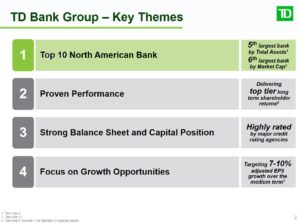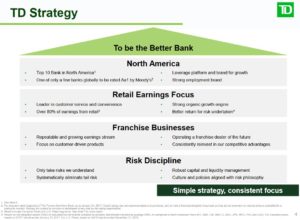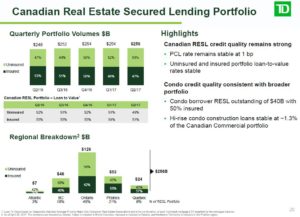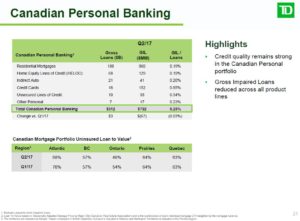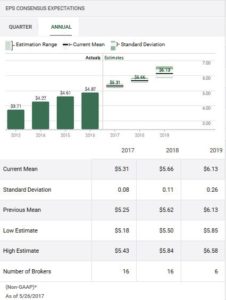Contents
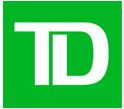 Summary
Summary
- This The Toronto-Dominion Bank Stock Analysis is the third of a 6 part series covering the Big 6 Canadian Banks.
- TD reported strong Q2 2017 results May 25th and its Capital Measure Ratios continue to be acceptable and stable.
- Pockets of the Canadian real estate market have been wildly overheated and a cooling appears to be taking hold.
- Investors are questioning what will be the impact on bank earnings if there is a major correction in real estate values.
- TD is an attractive long-term investment but I suspect we will experience a major market correction within the next 12 months and urge caution.
All figures are expressed in Canadian dollars unless otherwise noted.
Introduction
The Toronto-Dominion Bank (NYSE: TD), Canada’s 2nd largest bank by market cap, reported Q2 2017 results on May 25th.
Some historical fast facts about TD can be found here.
When I started my career in Canadian Banking in 1980, TD was either the 4th or 5th largest Canadian financial institution. In early 2000, while I was employed with TD, TD acquired Canada Trust. This was a wonderful acquisition and essentially gave notice to the competition of its intent to become a dominant player in the Canadian retail banking space. In fact, Canada Trust’s CEO (Ed Clark) eventually became TD’s CEO. During his tenure as TD’s CEO, several additional strategic acquisitions were made to expand the bank’s footprint and market share in retail banking and wealth management.
In 2004, TD announced it was acquiring a 51% stake in Banknorth so as to establish a foothold in the US. This brilliant strategic acquisition was completed in 2007 when TD acquired the remaining interest in Banknorth. In 2008, TD further expanded its presence in the North Eastern quadrant of the US when it merged with Commerce Bank.
Several smaller important acquisitions were also subsequently completed. Examples include TD’s acquisitions of Chrysler Financial, MBNA Canada's credit card business, Target’s credit card portfolio, Nordstrom’s credit card portfolio, and its purchase of 57 branches in Ontario and Western Canada from a much smaller Canadian competitor.
It now appears TD is satisfied that it has the appropriate scale in the US such that no further major acquisitions are planned in the foreseeable future.
While I touch upon various topics that impact the Canadian Banking Sector and the top 6 Schedule I Canadian Banks, I strongly encourage you to listen to the TD segment of the March 29 and 30, 2017 National Bank Financial Markets – 15th Annual Financial Services Conference. There is far too much information covered in this ~30 minute segment for me to give the content justice in this post.
The Canadian Banking Sector
Details on the Canadian Banking Sector can be found here.
Technological Innovation
Details about the Technological Innovation the Canadian banks are undertaking can be found here.
TD Overview
A high level overview of TD can be found here.
TD’s Key Themes and Strategy are summed up nicely in these images.
Q2 2017 Financial Results
Readers are encouraged to review TD’s Q2 2017 Earnings News Release and Results Presentation which were released May 25, 2017.
Capital Measure Ratios
In addition to touching upon the Capital Measure Ratios for TD, you can find more information here.
Recent Events in the Canadian Banking Sector
A brief overview about a few major Recent Events in the Canadian Banking Sector can be here.
Inflated Real Estate Values
Given the impact the US real estate bubble had on the US Banking sector, it is only fair that people should be wondering what would happen to the Canadian financial institutions if the grossly inflated real estate values in various major centres in Canada were to experience a correction.
Multiple articles have been published about the state of certain pockets of the Canadian real estate market and how consumers are stretched financially. Recently, more articles have appeared about the sudden cooling of the real estate market.
In addition to my opinion on this topic which can be found here, I have very recently attended Open Houses (a community on the outskirts of Toronto) so I could speak with various real estate agents and brokers. All have indicated they have noticed a marked change in the last couple of months. Buyers appear to be less aggressive and in all cases, Open Houses are getting much less foot traffic. They have also commented that there is concern that some buyers may be willing to risk the loss of their deposit and will just walk away from their offers.
TD’s Canadian Real Estate Secured Lending and Personal Banking Portfolios
In an effort to address concerns raised about the quality of their real estate portfolio, the Canadian financial institutions have provided information in their respective Q2 2017 Earnings Presentation.
While 53% of TD’s real estate portfolio consists of uninsured mortgages, the Loan to Value ratio averages 49%.
TD’s Provision for Credit Losses and Loans 90+ days past due appear to be well controlled. Naturally, if we enter an economic downturn we can certainly expect to see an increase from current levels. At the moment, however, there is no cause for alarm but caution is definitely warranted.
Risk Management
There are a host of risks the Canadian financial institutions face. Global uncertainty, Brexit, Oil & Gas, Cyber risk, anti-money laundering, renegotiation of NAFTA, and the increasing complexity of regulation are just a few of these other risks.
I recommend you review the Q2 Results Presentation for which a link was provided above as there are multiple pages that provide details addressing the quality of TD’s loan portfolio. There are also multiple pages in TD’s 2016 Annual Report addressing TD’s Risk Governance, Risk Management, and Business Model. Page 9 of the Annual Report lists the locations of the disclosures within the report.
Dividend
Unlike many foreign banks which were forced to dramatically reduce or suspend their dividend during the Financial Crisis, TD and its Canadian counterparts froze their quarterly dividend.
In late-2011, TD reinstated dividend increases. TD’s dividend distribution history dating back to 1969 can be found here.
TD is another Canadian financial institution with a lengthy history of uninterrupted quarterly dividend payments. The likelihood of a dividend cut or elimination is remote so investors seeking a safe dividend and a respectable dividend yield (~3.74% as I compose this) would be well served acquiring TD shares at current levels.
Valuation
The current mean FY2017 adjusted EPS estimates from various brokers for fiscal 2017 is $5.31.
As I compose this post, TD is trading at ~$64.25 on the TSX thus giving us a forward PE of ~12.1. When I look at the high/low PE ratio levels for the past several years I view the current level as acceptable and would consider adding to our existing position in addition to the TD dividends we have DRIPed for several years.
The Toronto-Dominion Bank Stock Analysis - Final Thoughts
In my opinion, TD is an ideal holding within a well-balanced and well-diversified portfolio if you are an investor with a long-term perspective. While TD is prudently managing its loan portfolio, has a strong capital base, and is reasonably valued at current levels, my major concern at this stage is that I suspect a major market pullback (also see here and here) will come about within the next 12 months. I, therefore, urge caution and suggest if you intend to acquire TD shares in the near-term that your purchases be made in small tranches. In the event a major market correction materializes, I would back up the truck and load up on TD.
Note: I appreciate the time you took to read this article and hope you got something out of it. As always, please leave any feedback and questions you may have in the “Contact Me Here” section to the right.
Disclaimer: I have no knowledge of your individual circumstances and am not providing individualized advice or recommendations. I encourage you not to make any investment decision without conducting your own research and due diligence. You should also consult your financial advisor about your specific situation.
Disclosure: At the time of writing this post I am long a few thousand shares of TD, BMO, RY, BNS, and CM. These holdings represent ~13.5% of our overall holdings and not just the FFJ Portfolio.
I wrote this article myself and it expresses my own opinions. I am not receiving compensation for it and have no business relationship with any company whose stock is mentioned in this article.


